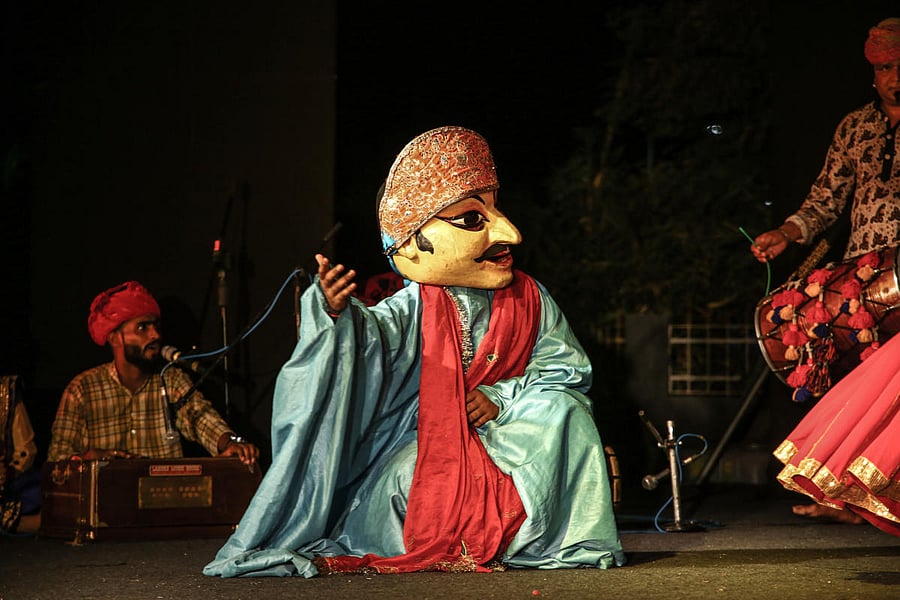When you look at puppets, they look so real. A closer look reveals a beautiful princess and a handsome prince. It’s said that the folk art tradition is dying. But it’s not so. Pose the question to Puran Bhat, the man behind the Delhi-based puppet theatre group Aakaar Puppet Theatre of traditional Rajasthani puppetry, “This art will never die,” Bhat responds, looking at his puppets and a huge crowd that enjoyed the group’s Swagat, which is designed to welcome visitors in Rajasthan.
The play consists of string and mask puppets, as well as live singing, fire dance and dummy horses and the Bhavai dance form.
“When you are putting up a puppetry show, apart from keeping traditions alive, show them (audiences) new things,” Bhat says, who has lost count of the number of shows he has done so far and the number of puppets that he has made.
Name any country — the US, the UK, France or Germany, he has done many workshops and shows there. “Many artistes are using my puppets. They have learnt to make puppets in the workshops. After completing a show in Austria, our shows are always in Rajasthani language, I asked the audience whether they have understood the story, and to my surprise, they retold the story. That’s why the language doesn’t matter when it comes to art,” says the 64-year-old Sangeet Natak Akademi Award winner.
The Bhat family has been into puppetry for generations now. Puppeteer Bhat tried his hand at different fields — theatre, TV shows, serials and so on — but he chose to go back to puppetry, which is his first love. Now, his eight children and 13 grandchildren are also into puppetry. “They all are well educated. I tell them don’t forget your tradition, culture and mother tongue,” says the puppeteer.
Differences
Aakaar Puppet Theatre group’s Dhola Maru and Swagat performances are quite popular not just in the country but abroad too. These are performed in the kathputli (means a puppet made of wood), form of string puppetry from Rajasthan, which then migrated across the region. This puppetry is performed by the Bhat community from Nagaur in the Marwar region.
“There are four forms — shadow puppetry, rod, string and glove puppetry. Shadow puppets are popular in Tamil Nadu and Kerala,” explains Bhat, adding that a string puppet is made out of mango wood andthe body is made of cotton.
Dressed like warriors, princesses and so on, kathputli is performed in festivals and fairs. Mostly, stories from the Ramayana and the Mahabharata dominate the repertoire of shadow puppetry, whereas, in string puppetry, the main story will always be about the kingdom.
“The root of this art can be traced back to the era of king Amar Singh Rathore. In those days, a puppet show meant eulogising the king and the kingdom. Even today, our shows are about the king, kingdom, the prince and the princess,” says Bhat.
In great numbers
Dhola Maru has been staged over 110 times. It is a folktale from northwestern Rajasthan that narrates the story of a young couple’s separation and reunion. This piece is narrated through a ballad and enacted as a nautanki or drama.
“When I look at things around me... like a table, a lamp, I am looking at them as puppets. There is so much to learn from puppets, and also, puppetry is not just an art, it teaches you acting, narration, lights, design and so on,” says Mahesh Rai, who is a part of Aakaar Puppet Theatre group.
Rai was doing a documentary on Puran Bhat and a show on a television channel on puppetry. He realised that there was so much to learn in puppetry that he joined Bhat.
“I take care of the light design, as it is an important element in puppetry. We use at least 30 lights for our performance,” says Rai.
Though puppetry shows are not financially rewarding, Bhat says, no matter what, he will always be a puppeteer and keep doing shows.
“All we need is more platform and shows. The art of puppetry is here to stay. People show a lot of interest in our workshops to make puppets, but yes, there is a world of difference between our country and the rest of the world in terms of platforms to showcase the art and talent. But things will change,” he says, packing all his puppets for another marvellous show.
